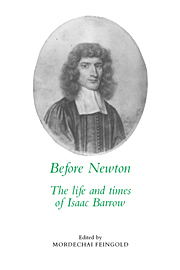Book contents
- Frontmatter
- Contents
- List of contributors
- Editor's preface
- 1 Isaac Barrow: divine, scholar, mathematician
- 2 The Optical Lectures and the foundations of the theory of optical imagery
- 3 Barrow's mathematics: between ancients and moderns
- 4 Isaac Barrow's academic milieu: Interregnum and Restoration Cambridge
- 5 Barrow as a scholar
- 6 The preacher
- 7 Isaac Barrow's library
- Index
1 - Isaac Barrow: divine, scholar, mathematician
Published online by Cambridge University Press: 05 November 2011
- Frontmatter
- Contents
- List of contributors
- Editor's preface
- 1 Isaac Barrow: divine, scholar, mathematician
- 2 The Optical Lectures and the foundations of the theory of optical imagery
- 3 Barrow's mathematics: between ancients and moderns
- 4 Isaac Barrow's academic milieu: Interregnum and Restoration Cambridge
- 5 Barrow as a scholar
- 6 The preacher
- 7 Isaac Barrow's library
- Index
Summary
The education of a scholar
Isaac Barrow appears to have descended from an ancient Suffolk family, but his immediate ancestors were professional men from Cambridgeshire. His great-grandfather was Philip Barrough, author of the popular Methode of physicke (1583) and a licentee by Cambridge University to practice chirurgy and medicine in 1559 and 1572, respectively. Philip's brother, Isaac, was elected a scholar of Trinity College, Cambridge, in 1560 and fellow the following year, graduating M.D. in 1570. He is said to have been tutor to Robert Cecil, the future lord treasurer, to whose father William, Lord Burghley, Philip Barrough's Methode of physicke was dedicated. Two of Philip's sons, Samuel and Isaac, matriculated at Trinity College in 1575 and 1584, respectively, the latter becoming a justice of peace at Cambridgeshire. Of the children of the J.P., Thomas was the father of the master of Trinity College, while his brother – yet another Isaac – was to become the bishop of St. Asaph.
In his old age, Thomas Barrow recollected that it was his father's severity that drove him to leave home and acquire a trade instead of following the footsteps of his ancestors into one of the three learned professions. Thus, “he came to London and was apprentice to a linnen-draper,” rising in due course to become linen draper to Charles I. In 1624, Thomas married Ann, the daughter of William Buggin of North Cray, Kent, who gave birth in October 1630 to Isaac Barrow. It appears that Barrow was the only child of this union – certainly the only child to survive infancy.
- Type
- Chapter
- Information
- Before NewtonThe Life and Times of Isaac Barrow, pp. 1 - 104Publisher: Cambridge University PressPrint publication year: 1990
- 2
- Cited by



